Electric cars do not need to change the brake pads: Truth or myth
The truth about replacing the brake pads in cars, Tesla and other electric cars
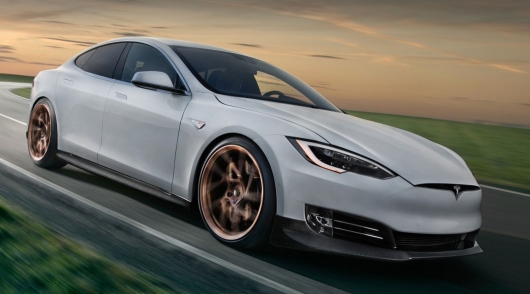
The holidays have passed and the festive mood someone left… the next day after Christmas the Tesla CEO, Elon Musk, made a surprise. He said that brake pads on cars Tesla literally “never” need replacing. This is partly thanks to the regenerative braking of the electric vehicle that reduce the use of brake pads compared to a conventional car with an internal combustion engine. It seems too good to be true! But maybe the truth really lies somewhere nearby? Let’s see. Moreover, far beyond the examples do not need to go a little research on the subject has been conducted at a large automotive site Jalopnik.com
We only give basic data on the conducted brainstorming.
But with this tweet Ilona began a discussion about the maintenance of electric cars:
The vast amount of energy of motion of the vehicle is returned to the battery, at a time when the electric motors act as generators. Tesla brake pads literally don’t need to be replaced throughout the life of the vehicle.
There aren’t many nuances to interpret what was said. Tesla will never need new brake pads, that’s what he’s talking about! Obviously, it doesn’t even matter how you drive.
But the system is regenerative (recuperative) braking, Tesla is not much different from those present on other EVs (electric vehicles) such as the Nissan Leaf, Chevy Bolt or Jaguar I-Pace. Experience experienced operating characteristics of electric vehicles so that they are possible to drive without using the brake pedal most of the time, especially in urban environments. Some developers even made a marketing move, highlighted in a separate “chip” feature of the electric motor:
Why to control the electric vehicle is quite a pedal
Yeah, really, the new Nissan Leaf, the brakes are positioned as a “backup options”. Don’t believe me, read while we go further in the study of global myth that electric cars do not need to change the brake pads…
That is what Musk was referring to in his tweet. However, this nuance may not work in every situation and is not for everyone, especially in those cases where the drivers often travel on the highway. In addition, you will need a brake for emergencies or simply unexpected surprises on the road, in everyday driving occur regularly.
To find out where “true” the dog is buried, researchers of the unknown turned to other developers of electric vehicles for Council.
First, here is what responded to the request of the representative of the Jaguar:
…brake pads for the I-PACE actually need periodic replacement. The frequency with which you have to do this procedure varies greatly from owner to owner, depending on his / her individual driving style.
I-Pace features 2 custom regenerative braking: “High” and “Low“.
In the mode “Low“, the resistance of the electric motors is unobtrusive, allowing the car to overrun for a long time, just as do cars with conventional internal combustion engines. When owner applies the brakes in this mode under normal braking conditions (i.e., not “panic” stop), and when the battery is below about 80% state of charge, the first part of the pedal stroke actually does not include brake pads/rotors, the car starts braking, relying on the use of the resistance of the motors to provide regenerative braking, transferring the braking energy back into the battery to increase charge. Of course, in a panic situation instantly brake pads biting the rotors to slow the car (causing wear).
In the operating mode “High” (one pedal) at I-PACE, the vast majority (but not all) requirements of braking can throw on the resistance of the motors. In most cases the driver will only use the accelerator pedal. This feature is especially useful in city traffic.
Of course, there are exceptions. The battery should be charged below 80% in order to receive the full benefit from resistance electric motors. The idea here is that we can’t recharge the battery and pack extra electrons if it is already fully charged, so the resistance provided by the engine, gradually decreases with increasing charge, requiring the use of a standard braking system.
In case of emergency or emergencies, the driver will rely on a combination of the resistance of the motor and the brake pads. This will naturally lead to some wear and tear, so at some point in the future will need to replace the pads. We recommend that you check the brakes have engaged qualified professionals (preferably in one of our retail retailers) during each service, or if the owner notices the noise or reduced braking ability, the indicator lights on the dashboard etc.
And here is the answer Chevrolet:
Features regenerative braking Bolt EV allow the car to slow down with little use of the primary hydraulic brake system. However, the actual mileage that can be extended service life of brake pads depends on the parameters of vehicle movement (e.g., how often the driver uses the functions of regenerative braking) and the environmental conditions in which the vehicle is operated.
In view of the fact that the actual mileage differs, the recommendation for owners: pay attention to the built-in pad-wear indicators.
Nissan, which was also conducted correspondence at the time of publication, no explanation given. However, here’s the excerpt from the manual:
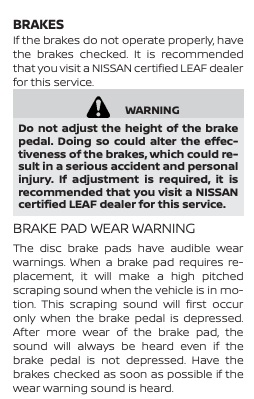
In short it says that you need to listen to the “squeaky” brake pads. This means that the replacement should on the car with the internal combustion engine to be produced on demand. Maybe less, but should.
Elon Musk lied to us?
What about the Tesla? “I wrote them e-mail, discussed with a representative of Tesla publication details, at their request, although there is still no official statement they sent was not. In any case, in my experience, Tesla is inclined to let Ilona tweets speak for themselves,” said the American journalist.
If we turn to the main document for the vehicle – owner’s manual Tesla, it turns out the following. Manual Tesla Model 3:
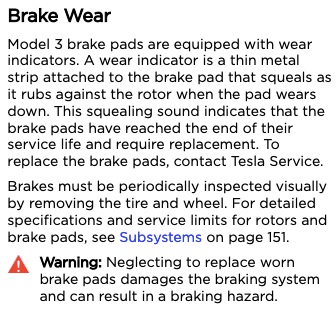
Tesla Model S:
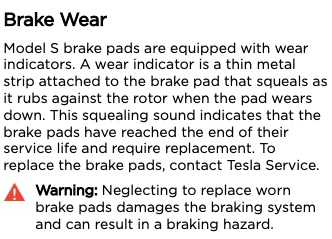
Tesla Model X:
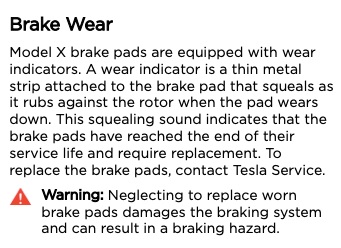
All three say that the brakes on cars have wear indicators, and that failure to replace worn brake pads “can lead to danger when braking.” All this, of course, assumes that you will ever need to replace the brake pads even in an electric car.
The conclusion from all this is quite simple, and the fact that most people know so, but because of smart marketing, what is absurdly wrong: brake pad wear depends greatly on how you will operate the car, which is true for all machines, not just for electric cars.
Therefore, it is not necessary to believe in the word of marketers and heads of corporations. Better look in the manual, it says it all. On this input the following result: brake pads in a Tesla like all electric cars need to be changed! Myth dispelled in down and ashes!
PS Interestingly, Musk just brought on an interplanetary orbit, its astronauts Starman? Maybe, too, a little FIB…?
